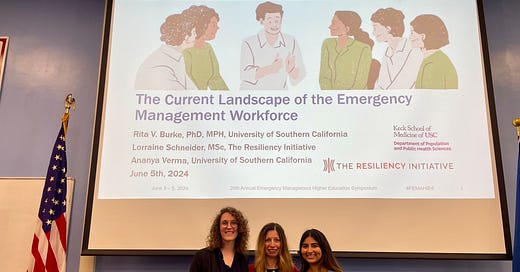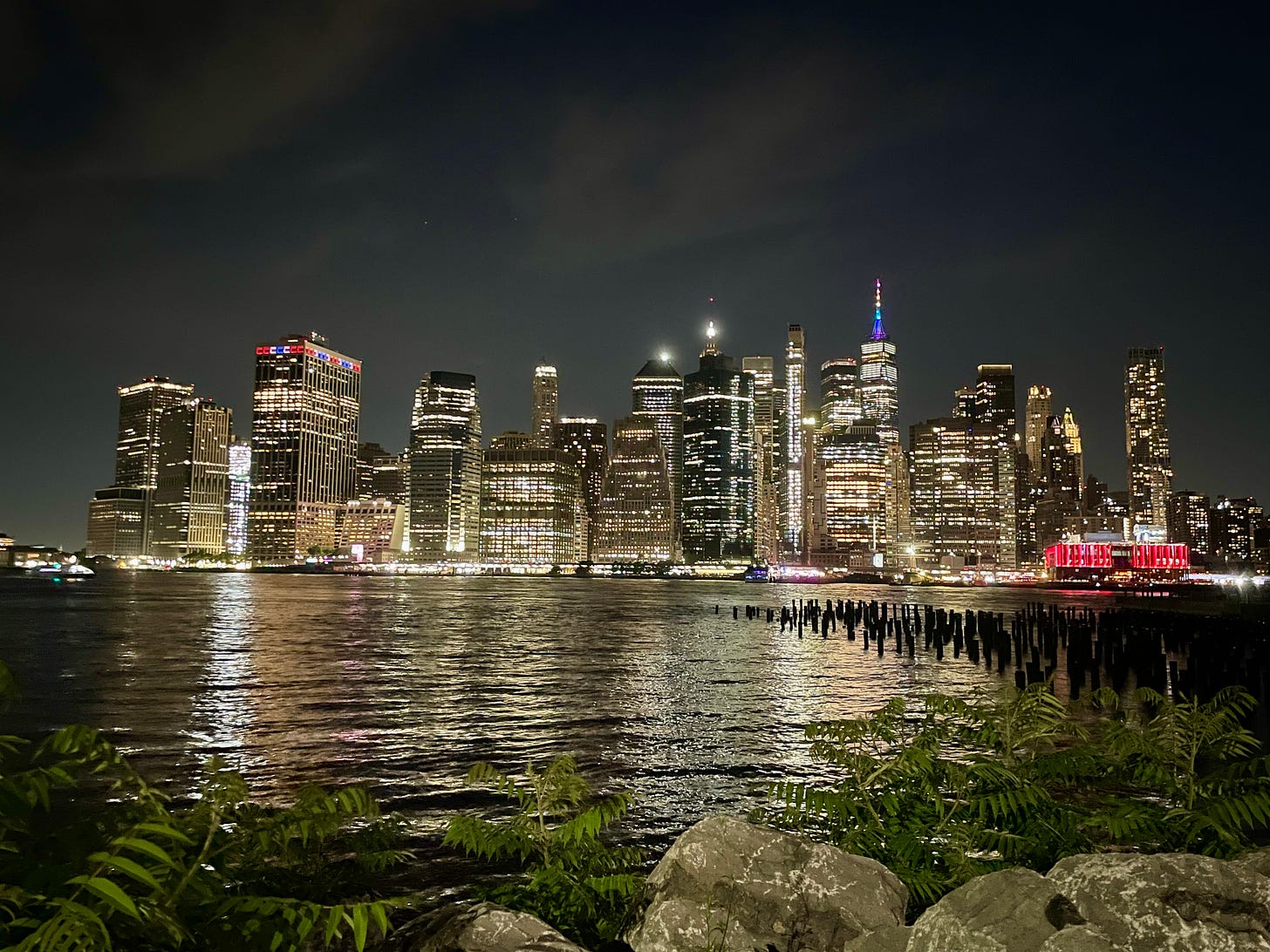Highlights from FEMA's 2024 Higher Ed Symposium
Bridging the digital divide, capacity building, and the Emergency Management University
What a busy month June has been! I had back-to-back trips to the Emergency Management Institute (EMI) in Emmitsburg, MD, followed by a reinvigorating team meet-up in Bentonville, AR.
This month, I focus on sharing highlights from the 2024 Higher Ed Symposium at EMI.
Things that caught my eye…
In 2017, I remember talking to a young couple staying in a shelter after Hurricane Harvey destroyed their home. They only had an old flip phone without internet access, which surprised me. I realized how naive I was to assume that everyone below a certain age owned a smartphone. Right away, I witnessed how much harder it was for them to access resources, whether it was to find a temporary home or to get in touch with their insurance and utility companies. This explains why my favorite session at FEMA’s 2024 Higher Ed Symposium was a panel discussion on how the lack of internet infrastructure contributes to the disproportionate impact felt by vulnerable populations after a disaster.
Monica Sanders, founder of The Undivide Project, was joined on stage by her team of young, diverse fellows who led The Ten States Project, a research initiative aimed at understanding the climate and disaster risks faced by African-American communities in 10 states across the Gulf and Mid-Atlantic regions. Many of these states have a low GDP, and they share the highest rate of folks without internet access. (According to Sanders, there are 21 million Americans who are not connected to the internet.) These 10 states are also home to 60% of the US’s African-American population and happen to be some of the most climate-vulnerable states in the country. In other words, this is where climate risk, digital divestment, and racial demographics all intersect. However, the Internet is not accounted for in federal recovery dollars for public assistance nor in hazard mitigation funding, thereby creating a huge resilience gap.
So, The Undivide Project works to create Internet-driven solutions and advocates for policy and legal frameworks to promote digital justice. As part of The Ten States Project, they collaborate with local communities, creating accessible risk maps and community resilience gardens. Check out and support their work.
If you’ve been anywhere near EM social media recently, you may have heard about FEMA Administrator Deanne Criswell’s announcement at the symposium that EMI would turn into a “university” effective July 1st. The details shared on the day were quite hazy. My initial gut reaction to this news was:
EMI already struggles to keep its current training curriculum up to date. How will it possibly expand and maintain a high-quality curriculum?
How will US politics and election cycles impact a government-funded and run university, and what will the repercussions be on our field?
Logistically, where and how are students going to be able to attend school? And who is going to staff it? Considering where EMI is at today as an institution, when and how is all of this going to take place?
In talking with EMI’s top two officials later on, it seemed like their vision for the “university” was different from what we typically would consider a university to look like. It wouldn’t grant degrees and would encompass three pillars: one focused on new/emerging emergency managers, one on mid-late career emergency managers, and one on individuals who perform work that touches emergency management, including nonprofit and private sector workers. (That last piece raised my alarm bells: Are we deepening the silo between emergency managers working for government institutions and all other categories of emergency managers?)
With such a lack of clarity, I’m not sure if we are merely dealing with poor messaging or semantics, but given the topic at hand, I thought it would be best to find out and share what educators in our field are saying. For a detailed analysis, check out Dr. Sam Montano’s newsletter and Dr. Carol Cwiak’s petition.
Some other presentations that stood out to me at the symposium:
For several years, Dr. DeeDee Bennett-Gayle at the University of Albany—SUNY has been collecting data on the US emergency management student population and higher education emergency management programs. Since 2004, about 90,000 students have graduated with a bachelor’s, master’s or PhD in emergency management. This year, 47% of respondents shared that volunteer or work experience in emergency management led them to study the field. This shows that we still have a long way to go to attract newcomers to emergency management.
Arthur Simental and his colleagues reviewed hundreds of emergency management job postings and compared their requirements with the curriculum currently taught at colleges and universities. Do they match up? Or is there a breakdown of what students are being taught vs. what emergency management agencies look for in their staff’s capabilities? FEMA will issue a full report over the summer.
Dr. Joshua DeVincenzo and his team at the National Center for Disaster Preparedness at Columbia University shared the new Climate Certificate Program they designed for FEMA. Courses are available online and across all 10 FEMA regions. For the perfect blend, they feature a teaching duo composed of an emergency manager and someone with a climate/sciences background. This is a welcome addition to EMI’s course catalog!
Dr. Rita Burke, Ananya Verma, and I presented our preliminary research findings on "The Current Landscape of the Emergency Management Workforce." After years of very limited data and anecdotal evidence that emergency management is not a diverse profession, it’s been rewarding putting numbers behind key demographic statistics. Among other things, we also collected data on salaries, sector representation, barriers to career growth, and the impact of reduced funding on emergency management organizations. Our research findings will be available to the wider public once published in a peer-reviewed journal.
Things I’m reading/listening to…
🏳️🌈 In Addressing the Challenges Facing the LGBTQIA+ Community in Disasters Amid Climate Change, Greg Padgett argues why incorporating LGBTQIA+ perspectives into the climate and environmental justice movements is essential for addressing disparities.
The Intergovernmental Panel on Climate Change (IPCC) emphasizes that marginalized populations bear the brunt of climate-related impacts. LGBTQIA+ individuals, who often face societal stigma, higher unemployment rates, and inadequate housing, are particularly susceptible to these adverse effects.
For a deeper dive into this topic, read Kevin Blanchard’s policy briefing Considering Mortality and Medical Decision-making for Gender and Sexual Minorities in Times of Disaster.
🏓 How does emergency management relate to pickleball? Find out in my podcast interview on "Life Lessons from Pickleball." It was fun exploring how managing nerves, teamwork, and communication are key ingredients of both elements. We also talked about personal resilience in the form of mindfulness and patience.
Things I’m looking forward to…
After being on the road non-stop for the past four months, I’m excited to spend the month of July enjoying the New York summer!
See you next time 👋🏽






